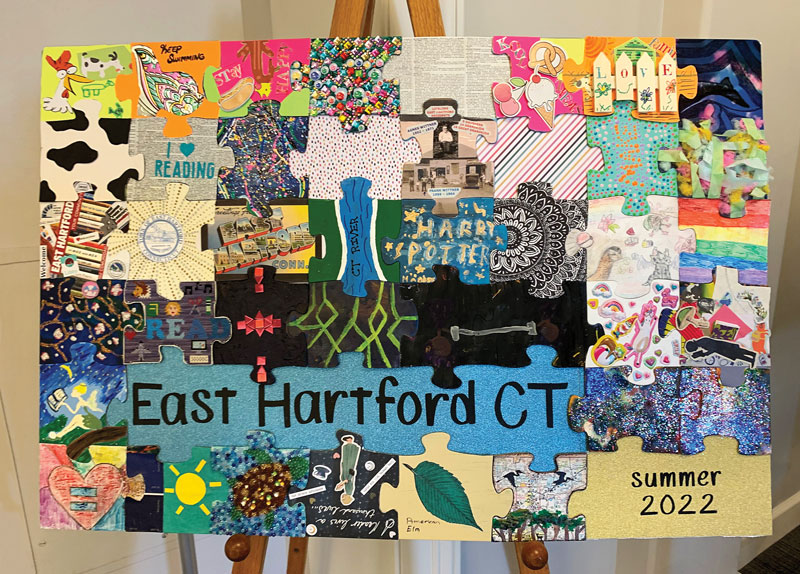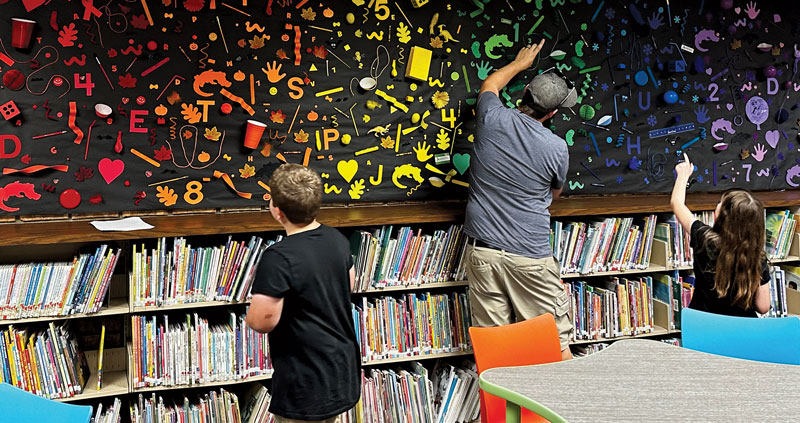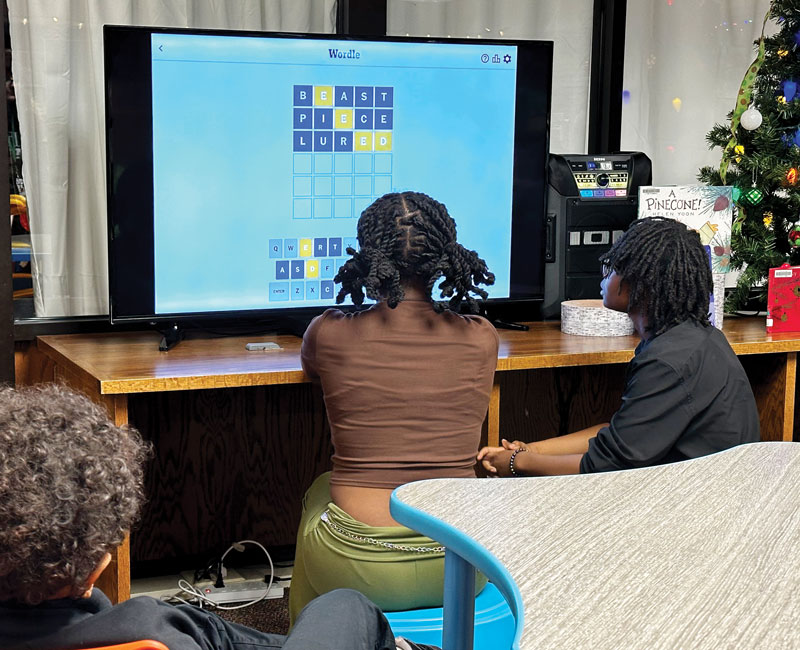Power-Up Programming with Puzzles!
Combat winter doldrums with group jigsaws, mindteasers, and more.
 |
A giant puzzle became a community art project at the East Hartford (CT) Public Library.Courtesy of the East Hartford Public Library |
Also read: |
January is National Puzzle Month, and it’s time to get indoors and celebrate! There are many ways to do so, with community jigsaw puzzles, puzzle swaps, and timed competitions, as well as game clubs, group word games, speed cubes, and break-in bags.
Puzzles offer flexible programming that naturally brings folks together. “Puzzling can be intergenerational and inspire teamwork,” says Jill Sollazzo, head of young adult services at the East Hampton (NY) Library. “While it may seem like a solitary activity—and it can be a relaxing one for a lot of people—doing puzzles is an important community-based activity.”
Studies have shown that early play with jigsaw puzzles improves young children’s spatial development and hand-eye coordination. Additional research shows that jigsaw puzzling mitigates cognitive decline in older adults—good reasons to encourage inter-generational participation.
Jigsaws are “a way to have engagement, build community, and provide health and mental benefits,” says Kelly Dalrymple, an engagement
specialist at the Metropolitan Library System in Oklahoma City. While group puzzling creates a feeling of connection, puzzling can also “provides stress relief and can calm people into almost a meditation state.”
But not during the library’s competitive puzzle races, Dalrymple jokes; the competition can be fierce as participants battle for the coveted prize: a 3-D printed jigsaw puzzle piece charm.
Other activities like group word puzzles can be a popular draw for the after-school crowd. So, where should you start? Take some tips from these public librarians.
The crowd-pleasing jigsaw
Considering starting a community jigsaw activity? Designate a large table and set around enough chairs to encourage multiple-patron participation. You can leave the puzzle out all day, but if you need to put it away, invest in a puzzle saver to roll up the work in progress and save it for later. Set out refreshments to attract patrons—Sollazzo entices her teens with cookies.
If your patrons prove eager to complete community puzzles, consider organizing an all-ages puzzle swap to bring more enthusiasts together, as did Angie Tomlinson, a library assistant with the Portage (WI) Public Library. Enthusiasts could bring in as many puzzles as they wanted to trade and then choose that same number from fellow participants. Tomlinson says that 31 patrons swapped more than 200 puzzles.
[Also read: DIY to the Rescue: 10 Librarian-Tested Passive Programs]
“Having the swap before winter started was imperative,” Tomlinson says. “A lot of people are more homebound as the weather changes in Wisconsin. The daylight hours are shorter, the weather is colder…. The patrons were excited to have ‘new to them’ puzzles.”
Leftover puzzles went to the library’s Friends group to sell, and the proceeds directly benefited the library.
The community puzzle proved to be popular with everyone, including library staff. Tomlinson reports, “Our director likes to pop out of her office and work on it a few minutes each day.”
 |
Adrienne De Luna turned two bulletin boards into an ever-changing game of I Spy at the the Whiting (IN) Public Library.Courtesy of the Whiting Public Library |
On your mark, get set, solve!
Are your patrons a more competitive crew? Consider puzzle races.
“Our people do not come to play,” says Dalrymple. The programming team at Metropolitan Library in Oklahoma City has set up a puzzle competition complete with winner prediction, prizes, bragging rights, and team names such as Jigsaw Junkies, Puzzlicious, We’re Puzzled, and the Piece Keepers.
Dalrymple sets a limit of six competitive teams of four people each. Preparation simply involves putting out tables and chairs, a clock to keep time, and sticky notes (for Dalrymple to note finishing times so she doesn’t forget). And of course, there are prizes. “Our branch is holding competitions quarterly,” says Dalrymple. The system’s programmers share a spreadsheet tracking puzzles and planning so they can share resources. “This allows us to have access to additional puzzles without spending too much from the individual branch engagement budget or storing the items.”
Dalrymple put her library’s 3-D printer to good use and printed jigsaw puzzle piece charms and keychains for the victors. “We recently added a Cricut Mug Press to our makerspace and are making mugs for the winning team.”
The fastest teams at Dalrymple’s library can complete 500-piece puzzles in under 45 minutes, she reports. For Tomlinson’s patrons, however, puzzle competitions are more about the journey. At an inaugural event, she set a 90-minute limit for teams of one to four people to complete a 500-piece puzzle. No team finished, so the group with the fewest pieces left won. Next time, she’ll set a two-hour limit.
Big-screen word games and a giant I Spy
The Whiting (IN) Public Library is a block away from the elementary, middle, and high schools, and Adrienne De Luna, the youth services librarian, welcomes anywhere from 20 to 40 kids of varying ages each day after school. “Puzzles are a great way for our staff to connect with kids and make the library feel like a welcoming, safe space,” De Luna says.
De Luna has used break-in bags, speed cubes, logic games, and some of the popular games from the New York Times, such as Wordle, Spelling Bee, and Connections. The break-in bags have proved especially popular. De Luna makes her own out of canvas bags with grommets and locks. Each bag features puzzles and riddles that must be solved in order to “break into” the bags and receive the prize inside, usually candy or a small trinket.
“We have two sets—one for children and another, slightly more challenging, for young adults,” De Luna says. Young patrons can borrow the bags from the circulation desk and work on them at the library. If they solve the puzzle and break into the bag, they get to keep whatever they find. If not, they can return the bag by the end of the day and try again another time.
As school lets out and the kids flow in, De Luna hooks her laptop up to a large screen that the library generally uses to advertise programs and services. De Luna turns it into a community puzzle-solving adventure with games from the Times.
“Whenever we put the games on the screen after school, kids naturally gather around to help solve them,” says De Luna. “We control the game from a laptop at the circulation desk, and the kids shout out their guesses as we go.”
 |
Casting Wordle to a large screen lets lots of kids play at the the Whiting Public Library.Courtesy of the Whiting Public Library |
Middle schoolers often gather to tackle Wordle together, De Luna says. “They groan when I suggest ‘beast’ as the go-to starting word—which is how I start the game every time—while they fiercely debate alternatives like ‘smart’ or ‘train.’ ” Meanwhile, younger children delve into Spelling Bee, testing out nonsensical words to see if they’re valid. “Sometimes the words end up being real, and we’re all learning something new that day!”
One middle schooler made himself the unofficial Wordle leader, clamoring to play every day and getting the others involved. “The kids share plenty of laughs over silly guesses and foster playful rivalries, but the real magic happens when they win as a team,” says De Luna. “The entire group will burst into cheers, celebrating their collaborative effort without even realizing how seamlessly they’ve worked together. The excitement is so rewarding.”
Also, she adds, they know they’ll get a little reward, which keeps them motivated (candy and small prizes really do go a long way).
Crosswords For Kids online has age-appropriate crossword games for younger players. It’s free and can be played on a big screen; the worksheets can also be printed for individual use.
Two large bulletin boards in De Luna’s children’s department were proving difficult to keep consistently and seasonally decorated, so De Luna turned them into one large I Spy game that kids look forward to playing daily.
De Luna’s team covered the boards in black paper and filled them with small, colorful trinkets arranged by color, creating a rainbow flow. “We used everything from crayons and popsicle sticks to pom poms and push pins,” De Luna says. “Right now, there are over 40 different items on the board. We keep adding more to keep it exciting.”
Each day, kids can come to the desk and pull a slip of paper at random from a jar; the paper tells them what items to look for on the board. They can complete one search and make one guess per day, which De Luna says keeps things fair and interesting—and makes young patrons want to come back. “If they guess correctly, they get to choose a prize from our treasure chest, which is stocked with stickers, candy, small toys, and leftover summer reading incentives,” says De Luna. “If they don’t get it right, they can try again the next day.”
Emily Wagner, the children’s librarian at Fox Lake (IL) District Library, hosted Missing Pieces, a puzzle and cypher club for young enthusiasts ages 8–12. Wagner’s goal: make learning math concepts fun and keep the kids refreshed over the summer break. The library hosted two sessions, one where the kids learned to solve a nonogram puzzle, and a second where they solved a complex sudoku. Wagner and her manager, Lindsey Tomsu, also suggest incorporating such activities into existing programs and offering the puzzles as brainteasers for the rowdy after-school crowd.
Community collaboration
Anna Eisen, the adult services librarian at the East Hartford (CT) Public Library, wanted to memorialize her community’s summer reading program with an “ambitious passive program” that would be open to the community at large, run for several weeks, and still be low cost and low effort for staff during the busy summer.
Using a three-by-five-foot ft children’s floor puzzle, Eisen and her staff distributed pieces to community members of all ages to take home and decorate, requesting that the decoration be related to the library or the East Hartford community.
Eisen numbered each piece on the back so she would know how to reassemble the puzzle as the decorated pieces returned over the summer. Out of 48 pieces, Eisen reports only 10 to 12 did not return (thanks to reminders from library staff). Eisen used colorful scrapbook paper to fill in the gaps, and the community hardly noticed the empty spots.
“Participants weren’t afraid to add dimension to their puzzle pieces,” says Eisen. “One person made a beaded mosaic, another cross-stitched on fabric and layered it over her puzzle piece, and someone bedazzled her puzzle piece with rhinestones and googly eyes!”
The community puzzle stayed on display in the library throughout the year so patrons could admire one another’s work every time they stopped in.
Puzzle programs are low effort, cost effective, and fun. And in a rapidly changing world, despite people’s differences, they offer everyone a place to fit in.
Lisa Bubert is a writer and children’s librarian in Nashville, TN.
RELATED
The job outlook in 2030: Librarians will be in demand
The job outlook in 2030: Librarians will be in demand
ALREADY A SUBSCRIBER? LOG IN
We are currently offering this content for free. Sign up now to activate your personal profile, where you can save articles for future viewing






Add Comment :-
Be the first reader to comment.
Comment Policy:
Comment should not be empty !!!